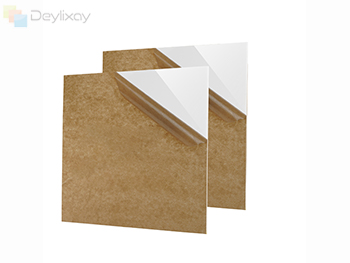Ibé akwụkwọ Acrylic, a makwaara dị ka iko acrylic, abụrụla ihe ọzọ a ma ama na ọdịnala ọdịnala n'ọtụtụ ngwa. Amalite na ha, ịdịte aka na ọnụ ahịa na-eme ka ha họrọ nhọrọ kachasị amasị ha maka ma ndị ahịa na ndị ọkachamara. Ma ị na-achọ ịrụ ọrụ Ndozi ụlọ ma ọ bụ ihe isi maka ịkpata, ịghọta ihe Njirimara, ngwa, na ịzụrụ Mpempe akwụkwọ acrylic dị mkpa. Ntụziaka a zuru oke ga-eje ije gị site na ihe niile ịchọrọ ịma gbasara akwa akwa acrylic.

A na-eme Mpempe akwụkwọ acrylic site na polyythyl metryrylate (pmma), polymer polymetik nke na-enye ike na ike na ike. N'adịghị ka iko, acrylic dị fechaa ma na-eguzogide mmetụta na-emetụta mmetụta, na-eme ka ọ dị mma maka ọnọdụ ebe nchekwa na ogologo oge bụ ihe na-ebute ụzọ. Ọ dị n'ọtụtụ dị iche iche, agba, ma mechaa, enwere ike ịhazi acrylic ka ha zupụta mkpa ụfọdụ, site na mpempe akwụkwọ doro anya na-emecha ma ọ bụ enyo.
Ngwongwo nke ekike nke akwa acrylic
1..
Mpempe akwụkwọ acrylic na-anya isi nke ọma, na-ahapụ ihe ruru 92% nke ọkụ na-ahụ anya gafere ọbụna iko dị mma. Nke a na-eme ka ihe dị mma maka ngwa maka ngwa dị ka Windows, ngosipụta, ihe mgbochi.
2. Mmetụta iguzogide
Ruo mgbe iri na asaa na-enwe mmetụta iguzogide iko, o yikarịrị ka acrylic bebly ga-agbaji ma ọ bụ mebie. Ihe onwunwe a na - eme ka ha daba adaba maka mpaghara ma ọ bụ gburugburu ebe nchekwa dị.
3. Ntughari ihu igwe
Acrylic na-eguzogide ọgwụ UV radieshon na ihu igwe, nke pụtara na ọ gaghị edo edo ma ọ bụ mesịa ngwa ngwa mgbe ekpughere ìhè anyanwụ ma ọ bụ oke okpomọkụ. Nke a na - eme ka ọ zuru oke maka ihe ịrịba ama dị n'èzí, akwụkwọ ndụ akwụkwọ ndụ, na mbara igwe.
4... Dị ka
Na-atụ ihe dị ka iko dị ka iko, akwa acrylic dị mfe iji aka, bufe, na ịwụnye. Nke a bara uru nke ukwuu maka nnukwu nrụnye ma ọ bụ ọrụ ebe ibu bụ ihe mgbochi.
5. Ngwunye
Enwere ike ịkpụ acrylic n'ụzọ dị mfe, gwuo egwu, sie ya, ma ọ bụ ngwaọrụ eji arụ ọrụ. Mgbanwe a na-enye ohere maka imewe na nhazi na-achọghị ngwa ọrụ ọpụrụiche.
6. Ntughari Chemical
Ọ bụ ezie na acrylic na-eguzogide ọtụtụ kemịkal, ọ nwere ike emetụta ya na mmanya dị ka mmanya ma ọ bụ acetone. Ọ dị mkpa ịtụle gburugburu ebe a ga-eji acrylic nke acrylic iji hụ na ịdị ogologo ndụ.
A na-ejikarị mpempe akwụkwọ acrylic
N'ihi ihe ha na-eme, a na-eji mpempe akwụkwọ acrylic gafee ọtụtụ ọrụ:
Bacrage na ngosipụta: Acrylic na-eji ọtụtụ ihe ịrịba ama maka ihe ịrịba ama, ngosipụta, na nke ire ya n'ihi na ọ ga-akpụzi n'ụdị dị iche iche.
Windows na glazing: ọdịdị ya na-eme ka ọ na-eme ihe na-eme ka ọ dị mma maka windo, ụlọ ọgwụ, na ụgbọ njem ọha.
Nku oku: Acrylic na-adị iche iche n'ụzọ ọ bụla, na-eme ya ihe a ma ama maka ụgwọ ọkụ, ogwe osisi, na mkpuchi.
Ngwongwo na ihe ndozi: Site na mbadamba ọgbara ọhụrụ na shelves e ji achọ mma, acrylic na-agbakwunye onye dị elu, nke oge ochie na-ele anya na ime ụlọ.
Aquariums na ngosipụta: ike na idoanya nke acrylic na-eme ka ọ dị mma maka nnukwu nesiums na ihe ngosi nka.
Greenhouses na skylits: nguzobe ihu igwe ya na ihe ndị na-ebufe na-eme ka acrylic zuru oke maka ngwa ụlọ na ụlọ obibi.
Ndụmọdụ maka ịzụta acrylic
1. Kpebie ụdị ziri ezi
Mpempe akwụkwọ acrylic na-abịa na ụdị abụọ dị iche iche: ewepụtara na nkedo nkedo. Acrylic acrylic bụ ndị dị ọnụ ala ma dị mma maka ebumnuche izugbe, ebe acryg nke ukwuu na Cellrylic na-enye ezigbo mma, ma na-akwalite ngwa ngwa maka ngwa usoro.
2. Họrọ ọkpụrụkpụ kwesịrị ekwesị
Ọkpụrụkpụ nke acrylic shets sitere na 1mm ruo 25mm. Mpempe akwụkwọ dị mkpa dị mma maka ime na ọgbụgba ọkụ, ebe akwa buru ibu dị mma maka ngwa usoro dị ka windo ma ọ bụ ihe mgbochi.
3. Tụlee agba na imecha
A na-enweta acrylic dị na nke ọma, na-atọ ụtọ, opaque, na enyo na-emecha. Chee echiche banyere ihe aesthetic na arụmọrụ ọrụ gị tupu ị na-ahọrọ.
4. Nyochaa onye na-eweta ya
Zụta site na ndị na-enye ndị na-eweta ihe ndị na-enye ihe dị oke mma na ọrụ ndị ahịa a pụrụ ịdabere na ya. Chọọ maka nyocha ma ọ bụ jụọ maka nlele iji hụ na ngwaahịa na-emezu ụkpụrụ gị.
5. Tụlee ọnụahịa
Ọ bụ ezie na acrylic dị ọnụ ala karịa iko, ọnụahịa nwere ike ịdị iche iche dabere na ụdị, ọkpụrụkpụ, na ndị na-eweta ya. Tụlee nhọrọ iji chọta uru kachasị mma maka mkpa gị.
6. Nchekwa na njikwa
Acrylic eyts na-adịkarị mfe ịkpụ. Jiri ihe nkiri echebe n'oge njikwa na nrụnye, ma jiri akwa dị nro na ndị na-anaghị adị ọcha na ndị na-anaghị adị ọcha.
Mmechi
Mpempe akwụkwọ acrylic bụ ihe dị iche iche, na-adịgide adịgide, na ọnụ ahịa-dị ọnụ ahịa maka ịgụta ebe obibi, ọrụ na ọrụ ụlọ ọrụ. Site na nghọta ha, ngwa, na ngwa ahịa, ị nwere ike ịme mkpebi dị mma nke dabara na mkpa gị. Ma ị na-emepụta akara ngosi na-ele anya, ma ọ bụ na-ebupụta ụlọ ọdịnala, exrylọ omenala na-enye ngwakọta zuru oke nke arụmọrụ na aesthetics.
 English
English Español
Español Portugues
Portugues Pусский
Pусский Français
Français Deutsch
Deutsch 日本語
日本語 한국어
한국어 العربية
العربية Italiano
Italiano Nederlands
Nederlands Ελληνικά
Ελληνικά Svenska
Svenska Polski
Polski ไทย
ไทย Türk dili
Türk dili हिन्दी
हिन्दी Indonesia
Indonesia Melayu
Melayu Tiếng Việt
Tiếng Việt dansk
dansk Magyar
Magyar қазақ
қазақ বাংলা
বাংলা עִברִית
עִברִית မြန်မာ
မြန်မာ українська
українська norsk
norsk Gaeilge
Gaeilge Română
Română ພາສາລາວ
ພາສາລາວ Filipino
Filipino Suomalainen
Suomalainen slovenský
slovenský o'zbek
o'zbek Hrvatski
Hrvatski Zulu South Africa
Zulu South Africa Afrikaans isiXhosa
Afrikaans isiXhosa lëtzebuergesch
lëtzebuergesch тоҷикӣ
тоҷикӣ नेपाल
नेपाल Eesti
Eesti Yoruba
Yoruba Монгол
Монгол ខ្មែរ
ខ្មែរ 中文(繁体)
中文(繁体) Afrikaans
Afrikaans












 Ekwentị
Ekwentị
Ikwu
(0)